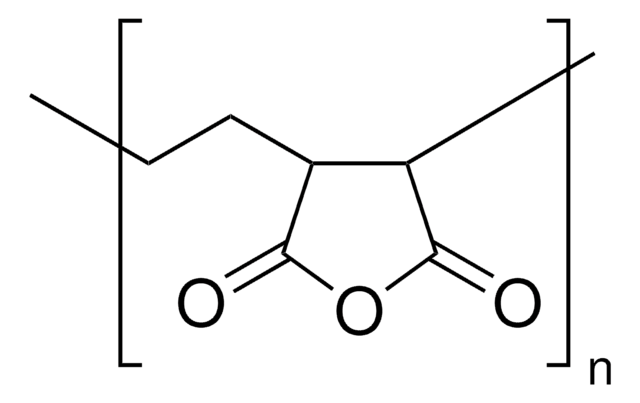531278
Poly(isobutylene-alt-maleic anhydride)
average Mw ~6,000, 12-200 mesh (85%)
Synonym(s):
maleated copolymer, maleated polymer, maleic copolymer
Sign Into View Organizational & Contract Pricing
All Photos(2)
About This Item
Linear Formula:
(C4H2O3 · C4H8)X
CAS Number:
MDL number:
UNSPSC Code:
12162002
NACRES:
NA.23
Recommended Products
mol wt
average Mw ~6,000
Quality Level
particle size
12-200 mesh (85%)
inherent viscosity
0.45±0.05 dL/g, in DMF(30 °C)(lit.)
transition temp
Tg (DSC) 141 °C (onset)
solubility
aqueous base: soluble
density
1.3 g/mL at 25 °C (lit.)
InChI
1S/C4H2O3.C4H8/c5-3-1-2-4(6)7-3;1-4(2)3/h1-2H;1H2,2-3H3
InChI key
RPOCFUQMSVZQLH-UHFFFAOYSA-N
Looking for similar products? Visit Product Comparison Guide
Related Categories
Application
Poly(isobutylene-alt-maleic anhydride) was used to prepare amphiphilic polymer with dodecylamine. The polymer is a dispersing and surface active agent.
Storage Class Code
11 - Combustible Solids
WGK
WGK 3
Flash Point(F)
Not applicable
Flash Point(C)
Not applicable
Personal Protective Equipment
dust mask type N95 (US), Eyeshields, Gloves
Choose from one of the most recent versions:
Already Own This Product?
Find documentation for the products that you have recently purchased in the Document Library.
Relaxation times of colloidal iron platinum in polymer matrixes.
Morales MP, et al.
Journal of Materials Chemistry, 19(35), 6381-6386 (2009)
Abhimanyu Paraskar et al.
Nanotechnology, 22(26), 265101-265101 (2011-05-18)
The use of cisplatin, a first line chemotherapy for most cancers, is dose-limited due to nephrotoxicity. While this toxicity can be addressed through nanotechnology, previous attempts at engineering cisplatin nanoparticles have been limited by the impact on the potency of
Divakara S S M Uppu et al.
Biomacromolecules, 17(3), 862-873 (2016-02-04)
Synthetic polymers incorporating the cationic charge and hydrophobicity to mimic the function of antimicrobial peptides (AMPs) have been developed. These cationic-amphiphilic polymers bind to bacterial membranes that generally contain negatively charged phospholipids and cause membrane disintegration resulting in cell death;
Delivering the goods.
Stefaan De Smedt et al.
Dalton transactions (Cambridge, England : 2003), (11)(11), C23-C23 (2007-04-13)
Alexandre Drogoz et al.
Biomacromolecules, 9(2), 583-591 (2008-01-23)
This work reports on the interactions of a model protein (p24, the capside protein of HIV-1 virus) with colloids obtained from polyelectrolyte complexes (PECs) involving two polysaccharides: chitosan and dextran sulfate (DS). The PECs were elaborated by a one-shot addition
Our team of scientists has experience in all areas of research including Life Science, Material Science, Chemical Synthesis, Chromatography, Analytical and many others.
Contact Technical Service


![Poly[(isobutylene-alt-maleic acid, ammonium salt)-co-(isobutylene-alt-maleic anhydride)] average Mw ~60,000](/deepweb/assets/sigmaaldrich/product/structures/208/717/cfb2dcac-b112-4e25-9140-f3649ec430ea/640/cfb2dcac-b112-4e25-9140-f3649ec430ea.png)



